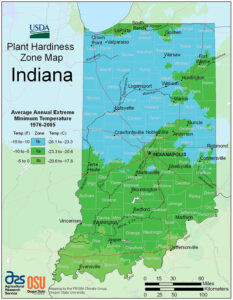When you think of palm trees, do you envision sun-drenched beaches, warm ocean breezes, and the laid-back lifestyle of tropical locales? It’s a delightful image, isn’t it? But here’s a playful twist: can palm trees even thrive in the chilly realms of Indiana? The answer is both intriguing and, admittedly, a bit complicated.
To begin with, Indiana’s climate is classified as humid continental. This means winters can be bitterly cold, with temperatures plummeting well below freezing, while summers can be swelteringly warm and humid. Given these climactic extremes, one might wonder if palm trees—icons of tropical scenery—can really make a home here. Let’s delve deeper into the particulars of palms, their varieties, and the challenges they face in a place known more for cornfields than coastlines.
First, it’s essential to understand that not all palm trees are created equal. In fact, there are over 2,500 species of palm trees, each with unique attributes, growth requirements, and resilience to cold weather. Among these species, some are more hardy than others, enabling them to withstand the rigors of Indiana winters. Take the needle palm, for example, which is recognized as one of the hardiest palms in the United States. With its ability to tolerate temperatures as low as 10°F, it can survive in zones where many other palms would not fare as well.
Another option for the intrepid gardener is the windmill palm, otherwise known as Trachycarpus fortunei. This particular species has gained popularity due to its adaptability and cold hardiness. You could say it’s a bridge between the tropics and the Midwest, allowing you to enjoy that exotic aesthetic even when the thermometer dips.
However, planting palm trees in Indiana is not just about choosing the right species. The location in which you decide to plant your palm plays a crucial role. Proper placement can significantly mitigate the risks posed by cold weather. South-facing areas that enjoy ample sunlight can offer a more hospitable environment, creating pockets of warmth that mimic a milder climate. Conversely, shady or exposed locations can lead to frost damage, stunted growth, or even demise during harsh winters.
So, what’s the catch? The transition from a tropical environment to one as variable as Indiana’s poses its own challenges. Factors like soil quality, humidity levels, and adequate drainage must be meticulously monitored. Palms generally prefer well-draining soil; thus, sandy or loamy types are ideal. Amending clay-heavy soils with compost can improve drainage, fostering healthier roots.
But it’s not merely about the soil; water management is equally critical. While palm trees are accustomed to tropical rainfalls, they can be susceptible to root rot in overly saturated conditions. Finding the right balance is essential. Consider installing a drip irrigation system that can provide steady moisture without drowning the roots—this could be your golden ticket to successful growth.
Moreover, if you’re genuinely eager to cultivate palms in Indiana, nurturing your trees before winter arrives is paramount. Many gardeners opt to wrap their palms in burlap or use heat lamps as temperatures drop. A protective barrier can keep the chill at bay, ensuring that your palm survives those biting nights. Consult with local gardening experts or extension services to get the best advice tailored to your specific region.
That said, perhaps the most captivating aspect of attempting to grow palm trees in a place like Indiana is the impact on your landscape design. Imagine stepping into your backyard, greeted by a majestic palm, its fronds swaying gently in the summer breeze. It’s a delightful incongruity that offers a striking contrast to the familiar Midwestern scenery. This juxtaposition creates not just a visual feast but also cultivates a talking point when entertaining friends or family.
Now, let’s not forget the emotional aspect. The sheer ambition and adventurous spirit involved in attempting to grow a palm tree in an area where such flora seems counterintuitive can be uplifting. It embodies the idea that with creativity and dedication, one can indeed bring a slice of paradise into a less-than-paradisiacal environment. It’s this element of hopeful rebellion against nature that appeals to many gardeners, echoing an earnest desire to inspire change and beauty in unexpected places.
In conclusion, can palm trees grow in Indiana? The answer is a resounding yes, with the right planning, selection, and care. It may require some effort and ingenuity, but the rewards are worth it. The ambition of introducing a tropical touch into a Midwestern backdrop invites not just a new layer of beauty but also a compelling narrative about resilience and aspiration. So, what’s holding you back? Embrace the challenge, and you might just find that Indiana can indeed be a home for palms—albeit a rare and extraordinary one!
